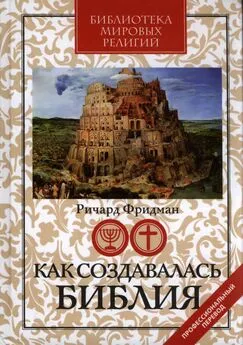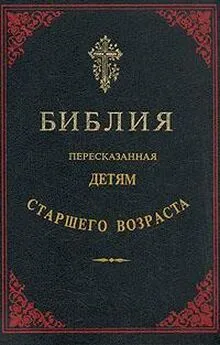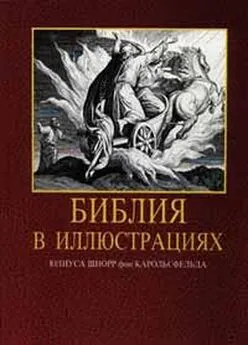Ричард Фридман - Как создавалась Библия
- Название:Как создавалась Библия
- Автор:
- Жанр:
- Издательство:Эксмо
- Год:2011
- Город:Москва
- ISBN:978-5-699-48351-8
- Рейтинг:
- Избранное:Добавить в избранное
-
Отзывы:
-
Ваша оценка:
Ричард Фридман - Как создавалась Библия краткое содержание
Это одна из тех редких книг, которым одновременно присущи увлекательность и научная глубина, выдержанность классической библейской критики и смелость в рассмотрении запретных для многих тем. Кем и в каком мире была создана Библия? Были ли авторы современниками описываемых событий? Были ли среди них женщины? Как связаны реальная история и библейские рассказы? Зачем была написана Библия?
Одна из самых ярких попыток понять Ветхий Завет в наше время.
The Independent (Лондон)
Книга увлекательна и легко читается, — настоящее событие. И в ней угадывается постижение правды. Harvard Magazine
Фридман вводит читателя в проблему библейского авторства, и делает это умно и тонко.
New York Times Book Review
«Как создавалась Библия» — книга увлекательная и блестящая. Это не просто рассказ об открытиях прошлого. Она полна новых идей и свежих находок.
Я прочел ее на одном дыхании. Большую часть жизни я провел, читая книги о Библии, и должен признаться, что не помню другого случая, когда я не мог бы оставить книгу не прочтенной.
Франк Мур Кросс, профессор еврейского и других ближневосточных языков (Гарвардский университет)
Ричард Элиотт Фридман — профессор еврейского языка и сравнительной литературы в Калифорнийском университете (Сан-Диего).
Он защитил докторскую диссертацию в Гарвардском университете, работал в Оксфордском и Кембриджском университетах.
Как создавалась Библия - читать онлайн бесплатно полную версию (весь текст целиком)
Интервал:
Закладка:
Эта песнь, известная также как Благословение Моисея, по-видимому, первоначально представляла собой отдельное произведение, затем вставленное в текст.
Эти стихи повторяют текст Р в Числ 27:12–14. Перед нами редакторский эпаналепсис, снова поднимающий вопрос о смерти Моисея. Понадобился из-за добавления Второзакония к произведению.
Библиография
Addis, W.E. Documents of the Hexateucb. London, 1892.
Aharoni, Yohonan. “The Solomonic Temple, the Tabernacle, and the Arad Sanctuary.” In H. A. Hoffman, Jr., ed., Orient and Occident , Cyrus Gordon Festschrift . Neukirchen: Neukir-chener, 1973.
Albright, William Foxwell. The Biblical Period from Abraham to Ezra. New York: Harper, 1963.
— From the Stone Age to Christianity. Garden City, N.Y.: Doubleday, 1946, 1957.
Alt, Albrecht. Essays on Old Testament History and Religion. Garden City, N.Y.: Doubleday, 1966. German edition, Kleine Schriften zur Geschichte des Volkes Israel , I, II, III, 1953.
Astruc, Jean. Conjectures sur les memoires originaux dont il parait que Moyse s`est servi, pour composer le livre de la Genese 1753.
Bacon, Benjamin W. The Genesis of Genesis. Hartford, 1892.
Baltzer, Klaus. The Covenant Formulary. Philadelphia: Fortress, 1971. German edition, 1964.
Bright, John. A History of Israel, 3rd ed. Philadelphia: Westminster, 1981.
Brown, Raymond E.; Fitzmeyer, J. A.; and Murphy, R.E., eds. The Jerome Biblical Commentary. Englewood Cliffs, N.J.: Prentice-Hall, 1968.
Busink, Th.A. DerTempelvon Jerusalem. Leiden: Brill, 1970.
Carpenter, J. E., and Harford-Battersby, G. The Hexateuch. London: Longmans, Green, 1902.
Cheyne, Т. K. Founders of Old Testament Criticism. London: Methuen, 1893.
Clements, R. E. Abraham and David. London: SCM, 1967.
Cross, Frank Moore. С anaanite Myth and Hebrew Epic. Cambridge: Harvard, 1973.
- “The Priestly Tabernacle.” Biblical Archeologist 10 (1947): 45- 68.
Driver, S. R. Introduction to the Literature of the Old Testament. Gloucester: Peter Smith, 1972. Original edition, 1891.
Duff, Archibald. History of Old Testament Criticism. London: Watts, 1910.
Eissfeldt, Otto. The Old Testament, an Introduction. P. R. Ackroyd, trans. Oxford: Basil Blackwell, 1965.
Emerton, J. A. “The Origin of the Promises to the Patriarchs in the Older Sources of the Book of Genesis.” Vetus Testa-mentum 32:14–32.
Engnell, Ivan. A Rigid Scrutiny. Nashville: Vanderbilt University Press, 1969.
Fohrer, Georg. Introduction to the Old Testament. Nashville: Abingdon, 1968.
Frankfort, Henri; Frankfort, H.A.; Wilson, John; Jacobsen, Thorkild; and Irwin, W. A. The Intellectual Adventure of Ancient Man. Chicago: University of Chicago Press, 1946.
Freedman, David Noel. “Divine Commitment and Human Obligation.” Interpretation 18 (1964): 419–431.
_ “Pentateuch.” Interpreters Dictionary of the Bible.
_ Pottery, Poetry, and Prophecy. Winona Lake, Ind.: Eisenbrauns, 1980.
Friedman, Richard Elliott, ed. The Creation of Sacred Literature. Berkeley: University of California Press, 1981.
_ The Exile and Biblical Narrative. Harvard Semitic Monographs. Decatur, Ga.: Scholars Press, 1981.
_ ed. The Poet and the Historian. Harvard Semitic Studies. Decatur, Ga.: Scholars Press, 1984.
_ “The Tabernacle in the Temple.” Biblical Archeologist 43 (1980).
_, and Williamson, H. G. М., eds. The Future of Biblical Studies: The Hebrew Scriptures. Semeia Studies: Decatur, Ga.: Scholars Press, 1986.
Grant, Robert M. A Short History of the Interpretation of the Bible. New York: Macmillan, 1948.
Gray, Edward M. Old Testament Criticism. New York: Harper, 1923.
Habel, Norman. Literary Criticism of the Old Testament. Philadelphia: Fortress, 1971.
Hahn, E. The Old Testament in Modem Research. Philadelphia: Fortress, 1966.
Halpern, Baruch. The Constitution of the Monarchy in Israel. Harvard Semitic Monographs. Decatur, Ga.: Scholars Press, 1981.
_ The Emergence of Israel in Canaan. Society of Biblical Literature Monographs. Decatur, Ga.: Scholars Press, 1983.
_ “Sectionalism and the Schism.” Journal of Biblical Literature 93 (1974): 519–532.
Hanson, Paul. “Song of Heshbon and David’s NIR.” Harvard Theological Review 61 (1968): 297–320.
Haran, Menahem. “The Priestly Image of the Tabernacle.” Hebrew Union College Annual 36 (1965): 191–226.
_ “Shiloh and Jerusalem: The Origin of the Priestly Tradition in the Pentateuch.” Journal of Biblical Literature 81 (1962): 14–24.
_ Temples and Temple Service in Ancient Israel. New York: Oxford, 1978.
Herrmann, S. A History of Israel in Old Testament Times. Philadelphia: Fortress, 1975.
Hillers, Delbert. Covenant: The History of a Biblical Idea. Baltimore: Johns Hopkins, 1969.
Hobbes, Thomas. Leviathan, Part 3, Chapter 33. 1651.
Hurvitz, Avi. “The Evidence of Language in Dating the Priestly Code.” Revue Biblique 81 (1974): 24–56.
— A Linguistic Study of the Relationship Between the Priestly Source and the Book of Ezekiel. Cahiers de la Revue Biblique. Paris: Gabalda, 1982.
Hyatt, J. P. “Torah in the Book of Jeremiah ” Journal of Biblical Literature 60 (1941): 381–396.
Ishida, Tomoo, ed. Studies in the Period of David and Solomon and Other Essays. Tokyo: Yamakawa-Shuppansha, 1982.
Jenks, Alan W. The Elohist and North Israelite Traditions. Decatur, Ga.: Scholars Press, 1977.
Kapelrud, A. S. “The Date of the Priestly Code.” Annual of the Swedish Theological Institute III (1964): 58–64.
Kaufmann, Yehezkel. The Religion of Israel. Trans, and ed. Moshe Greenberg. Chicago: University of Chicago Press, 1960. Hebrew edition, 1937.
Kennedy, A. R.S. “Tabernacle.” Hastings Dictionary of the Bible IV: 653–668.
Knight, Douglas A. Rediscovering the Traditions of Israel. Society of Biblical Literature Dissertation Series. Decatur, Ga.: Scholars Press, 1973.
Levenson, Jon. “Who Inserted the Book of the Torah?” Harvard Theological Review 68 (1975): 203–233.
_, and Halpern, Baruch, eds. Traditions in Transformation: Turning-Points in Biblical Faith. Essays presented to Frank Moore Cross. Winona Lake, Ind.: Eisenbrauns, 1981.
Liver, Jacob. “Korah, Dathan, and Abiram.” S cripta Hieroso-lymitana 8. Jerusalem: Hebrew University, 1961.
Lohfink, Norbert. “Auslegung deuteronomischer Texte, IV”. Bibel und Leben 5(1964).
Lundbom, Jack R. “The Lawbook of the Josianic Reform.” Catholic Biblical Quarterly 38 (1976): 293–302.
Malamat, Abraham. “The Twilight of Judah: In the Egyptian-Babylonian Maelstrom.” Vetus Testamentum Supplements 28 (1975): 123–145.
_ “Origins and the Formative Period.” In H. H. Ben-Sasson, A History of the Jewish People , pp. 3-87. Cambridge, Mass.: Harvard University Press, 1976.
May, Herbert, ed. Oxford Bible Atlas, 3rd ed. New York: Oxford, 1981.
McBride, Samuel Dean. “The Deuteronomic Name Theology.” Dissertation, Harvard University, 1969.
McCarthy, D. J. Old Testament Covenant. Richmond: John Knox, 1972.
_ Treaty and Covenant. Rome: Pontifical Biblical Institute, 1963.
McEvenue, Sean. The Narrative Style of the Priestly Writer. Rome: Pontifical Biblical Institute, 1971.
McKenzie, Steven L. The Chroniclers Use of the Deuteronomistic History. Harvard Semitic Monographs. Decatur, Ga.: Scholars Press, 1984.
Mendenhall, G. E. Law and Covenant in Israel and the Ancient Near East. Pittsburgh: Biblical Colloquium, 1955.
Milgrom, Jacob. Cult and Conscience. Leiden: Brill, 1976.
_ Studies in Levitical Terminology, I. Berkeley: University of California Press, 1970.
Moran, W. L. “The Literary Connection Between Lev 11:13–19 and Deut 14:12–28.” Catholic Biblical Quarterly 28 (1966): 271–277.
Mowinckel, S. Erwagungen zur Pentateuch Quellenfrage. Trondheim: Universitetsforlaget, 1964.
Myers, Jacob М. E zra/Nehemiah, The Anchor Bible. Garden City, N.Y.: Doubleday, 1965.
Nelson, Richard. The Double Redaction of the Deuteronomistic History. JSOT Supplement Series. Sheffield, 1981.
Nicholson, E.W. Deuteronomy and Tradition. Philadelphia: Fortress, 1967.
_ Preaching to the Exiles. Oxford: Blackwell, 1970.
Noth, Martin. Exodus. Philadelphia: Westminster, 1962.
_ A History of Pentateuchal Traditions. Englewood Cliffs, N.J.: Prentice-Hall, 1972. German edition, 1948.
_ The History of Israel. New York: Harper and Row, 1960. German edition, 1958.
_ The Laws in the Pentateuch. Edinburgh: Oliver and Boyd, 1966.
_ Leviticus. Philadelphia: Westminster, 1965.
_ Numbers . Philadelphia: Westminster, 1968.
_ The Old Testament World. Philadelphia: Fortress, 1966. German edition, 1964.
_ Uberlieferungsgeschichtliche Studien. Tubingen: Max Niemeyer Verlag, 1957. Original edition, 1943. Pp. 1-110 in English translation as The Deuteronomistic History. JSOT Supplement Series. Sheffield, 1981.
Perdue, L.G., and Kovacs, B.W., eds. A Prophet to the Nations: Essays in Jeremiah Studies. Winona Lake, Ind.: Eisenbrauns, 1984.
Polzin, Robert, Late Biblical Hebrew: Toward an Historical Typology of Biblical Hebrew Prose. Decatur, Ga.: Scholars Press, 1976.
Pritchard, James B., ed. Ancient Near Eastern Texts Relating to the Old Testament , 3rd ed. Princeton, 1969.
Propp, William H. “The Skin of Moses 5 Face — Transfigured or Disfigured?” Catholic Biblical Quarterly , 1987. von Rad, Gerhard. Deuteronomy: A Commentary. London: SCM, 1966.
_ Genesis. Philadelphia: Westminster, 1961.
_ Der Priesterschrift im Hexateuch (Berlin: W. Kohlhammer, 1934).
_ The Problem of the Hexateuch. New York: McGraw-Hill, 1966.
Rendsburg, G. “Late Biblical Hebrew and the Date of P.” Journal of the Ancient Near East Society 12 (1980): 65–80.
Rendtorff, Rolf. Das iiberlieferungsgeschichtliche Problem des Pentateuch (Beihefte zur Zeitschrift fur die alttestamentiche Wissen-schaft 147. Berlin/New York: Walter de Gruyter, 1977.
Rogerson, John. Old Testament Criticism in the Nineteenth Century: England and Germany. London: SPCK, 1984.
Rowley, H. H. The Old Testament and Modern Study. New York: Oxford, 1951.
Sarna, Nahum. “Hebrew and Bible Studies in Medieval Spain.” The Sephardic Heritage, vol. 1. London: Vallentine, Mitchell, 1971.
van Seters, J. Abraham in History and Tradition. New Haven: Yale University Press, 1975.
Shiloh, Yigal. Excavations at the City of David, vol. 1. Jerusalem: Institute of Archeology, Hebrew University, 1984.
Читать дальшеИнтервал:
Закладка:










